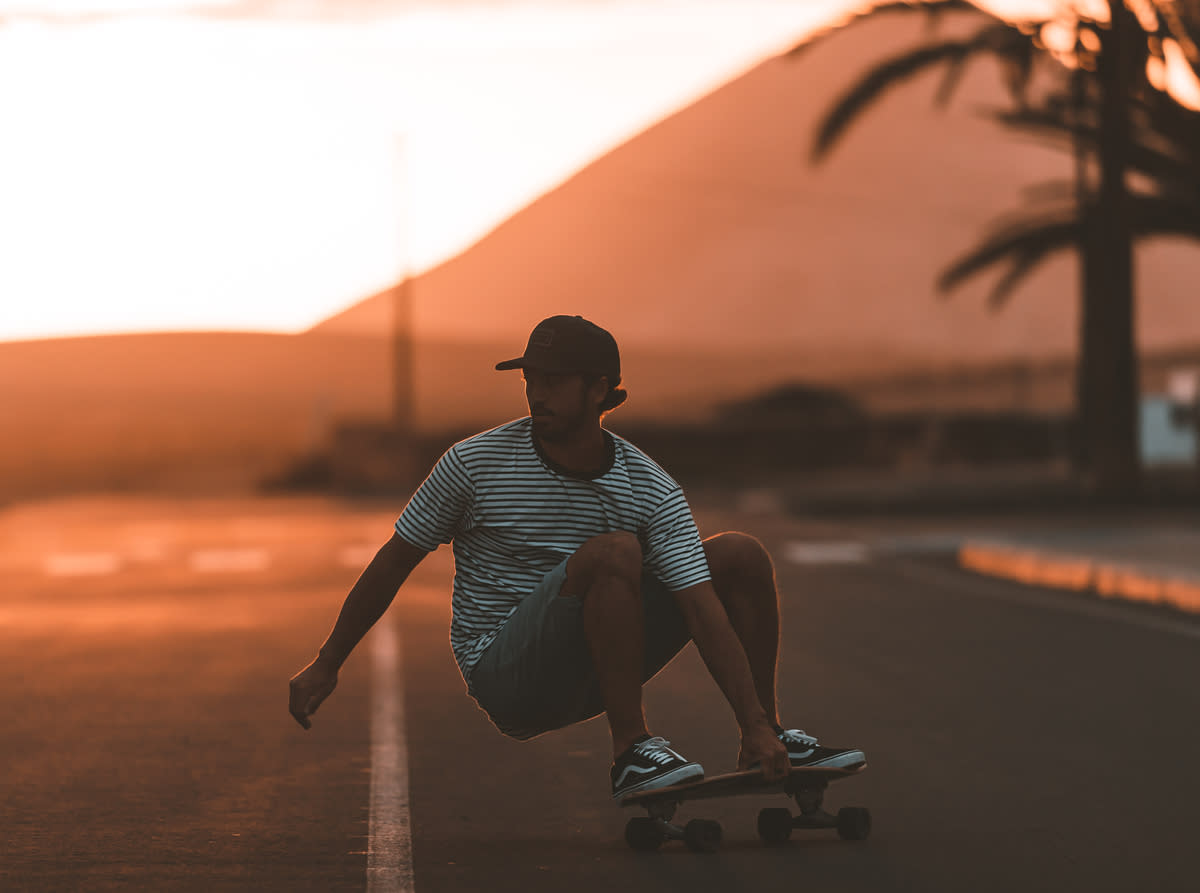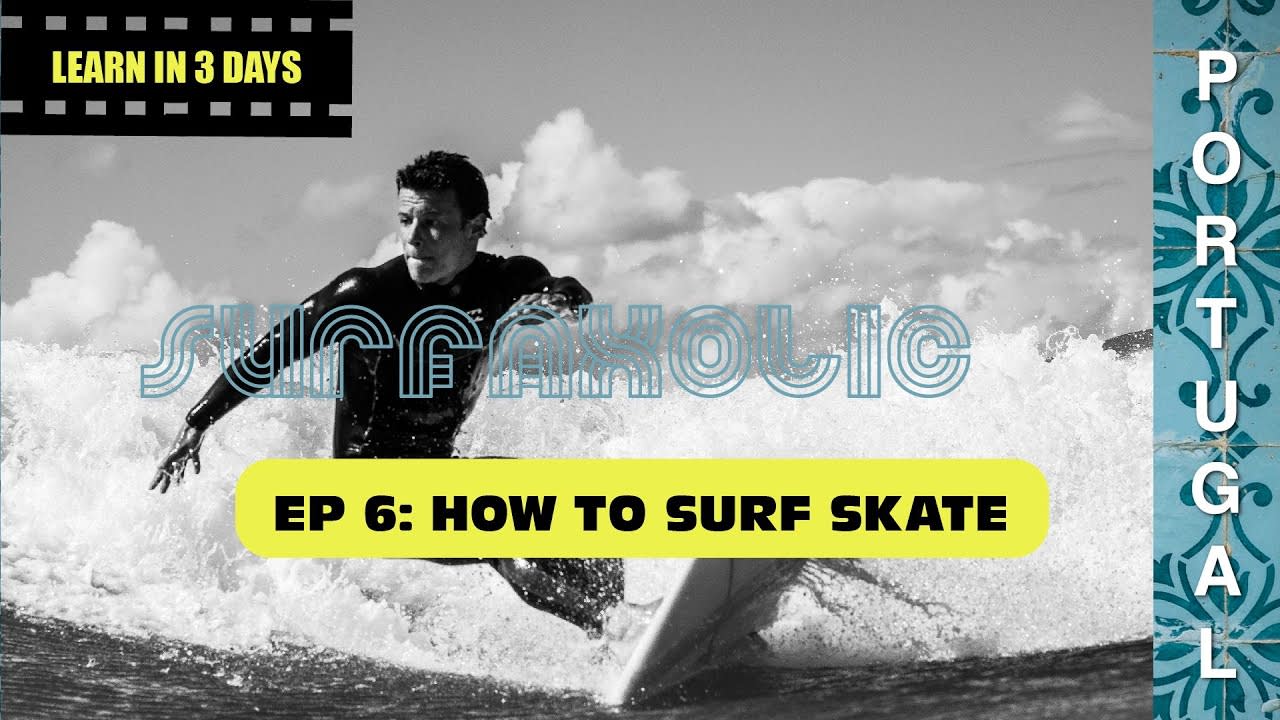
How to use surfskate to level up your surfing
February 18, 2025Take your surfing skills to the next level – on land! In this post, we’ll show you how surfskating mimics the flow and movements of surfing, helping you sharpen your technique, stay surf-fit, and ride with more confidence when you’re back in the water. Plus, we’ve got a handy how to-guide to get you rolling right away!
Don’t we all dream of surfing like Carissa Moore, Mick Fanning, Kelly Slater and other professional surfers? We secretly visualize ourselves surfing a wave as they do. Dreaming of the ability to make sharp turns on our shortboard or balancing graciously on the nose on our longboard.
They just make it look so easy. No matter if they are surfing on beach- or reef-breaks, in shallow or deep water – every one of those surfers looks like they are in total control of what’s happening out there.
But how do we get better after an amazing surf holiday? What if we live in places with no ocean around the corner?
Watching videos of surf techniques, keeping fit and practising our take-offs on the carpet beside our bed is one way to improve. But a few years ago, a few clever minds came up with another brilliant solution – and we’re not talking about river waves.
The solution is called surfskate! This post will tell you how to improve your surfing skills in the ocean with this special board on land.
You can also start by watching our guide video right below.
VIDEO
How to use surfskate to level up your surfing

Learning to surfskate: a guide to generating speed
In order to get the most out of a wave, it’s important to not only pick the right surfboard but also know the rules at the lineup and do a good take-off/pop up.
You probably heard someone saying he or she wants to learn how to ‘generate speed’ or the slang word ‘pumping’. Or maybe you happened to see people surfing a wave for a greater distance than you at the same spot.
How do they do that?
That is where surf skate comes into play. Using this precious tool can be THE solution and be great for improving balance and taking your surfing to the next level.
Let’s break down how to get speed using a ‘pumping technique’ and start having some REAL fun in the ocean!
When following the face of the wave, surfers draw curves (like sinus curves known from maths in school) with their surfboards. The reason for that is simple.
Imagine yourself at the line-up. You have done your pop up/take off and are ready to surf the wave. You are at the pocket of the wave, getting momentum and until you’re at the bottom of the wave.
Then suddenly lose all speed and the wave is continuing without you. How do we keep up? Buying a fish is one way to go. But a fast board doesn’t make you stay on the wave. Without the right technique. The keyword for success is TURNS. With turns, you can generate the speed needed. It creates a wonderful and smooth start to following the manoeuvres you are planning to do. It all starts with the first bottom turn.
This is the way pro surfers start surfing the wave too.
Learning to Surfskate: The bottom turn
After sliding to the bottom of the wave face, it’s time to turn by ca.180 degrees (bottom turn) and make a comeback towards the top of the wave. This is followed by another 180-degree turn at the peak, leading you back to the bottom of the wave face (top turn) - and so the sinus curve along the wave continues.
It has been said that the bottom turn is the foundation for any following tricks. If you dream of doing cutbacks or even aerials in the future, practice starts with that bottom turn.
Learning to Surfskate: Using the top-and-bottom-turn theory

The movements to generate speed on the Surfskate are similar to a surfboard. Speed is generated through turning. Using your bodyweight, arms and power in your legs you guide your board. In general, there is no need to push yourself forward like on a skateboard.
The movements on a Surfskate are all about the contraction and expansion of your legs. This is where the word ‘pumping’ originates from. In order to do that (and keep your balance) you need flexibility in your knees, so keep the legs a small bit bent.
Step by step guide on how to use a surf skate
Start with imagining you are dropping down the face of the wave. You want to perform your first bottom turn. Just this time, you are not on a surfboard in the ocean but standing on a smooth surface.
Put one foot on your Surfskate, the other on the ground. Put the front foot just behind the front screws, where the trucks are. If the front foot is a bit too far in the front you could fall so be careful.
Push yourself with the backfoot one time to gain momentum and step onto the board with your back foot to balance on the board.
When that stage is mastered, move on to the next:
Ask a friend to push you at a steady speed when standing on the surf skate with both feet.
Start shifting your weight from front to back foot and feel how the board is adjusting.
Put pressure on your heels, and then the toes. Try and get the Surfskate to perform a wave-like motion. Focus on the heel-to-toe movement.
Note:
Frontside turning = pushing toes
Backside turning = pushing heels
Once you feel stable and comfortable, try and include your body to enhance the movement of the surf skate.
Put pressure on your toes and join the movement with
your head (always look the way you go)
followed by your front arm as a guide
bend your legs down while you enter the 180-degree turn
Then push your heels into the surf skate while extending your legs and gain momentum.
Sounds very familiar to surfing, doesn’t it? When you have mastered this, you performed a bottom turn. If in the ocean, you would be on your way back up to the peak of the wave. The bottom turn is followed by another turn in the opposite direction to get back to the bottom of the wave.
The same technique as described above is needed.
Although this sounds a bit tricky, progress takes place with every try. Even without being in the ocean, or perhaps even faster. No need to paddle and wait for the wave because you can simply try again and again.
Surfing progression with surf skating at Lapoint

We have been able to make a dream come true and made pump tracks available at our premises in different locations. Mostly there is smooth-surfaced roads or public skate bowls available for practice too when at the camps. Therefore, you can already start learning and practising surf skating while on your surf vacation!
Feel free to check out our video on surf skating to see how movements on the surf skate look like: Learn to Surf Skate
We hope this encouraged you to get out there and try for yourself! Always remember: fall seven times, stand up eight and keep on shredding!
NEWSLETTER
Stay up to date, sign up for our newsletter

Maren Gimnes
Maren is a copywriter and content creator with a true passion for exploring the beautiful planet we call home. Her love for the ocean and salty days brought her to Lapoint, where she’s been living the digital nomad life and visiting our surf camps in all corners of the world. Maren aims to inspire others to pursue the surf lifestyle, to never miss a sunset and to follow their dreams.

